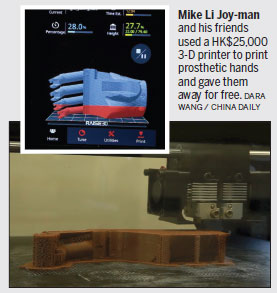Shifts in public facilities
Updated: 2017-12-21 06:24
By Dara Wang in Hong Kong(HK Edition)
|
|||||||
There's considerable caution about prosthetics at Hong Kong research centers with 3-D printing equipment.
The Hong Kong Polytechnic University opened its University Research Facility in 3-D Printing (U3DP) in April. It has around 50 to 60 3-D printers, priced between HK$20,000 and HK$8 million. The lower-priced ones are used by students for class assignments, the expensive ones for metal printing.
The 3-D center collaborated with Queen Elizabeth Hospital to create a simulator to train staff in a minimally invasive cardiac procedure to repair the aortic value. In practice the procedure, known as transcatheter aortic valve implantation (TAVI), involves wedging a replacement valve into the aortic value, without removing the damaged aorta.
Man Hau-chung, dean of the Faculty of Engineering and director of U3DP at PolyU, said the major components for the simulation system were all 3-D-printed, including arteries and blood vessels. Other devices included a transparent mask for patients recovering from facial injuries, and a set of 3-D-printed scalpels for the bone surgery.
Although 3-D printing provides a level of customization that appears promising for the future of prosthetics, both the Hospital Authority and the university are treading softly.
Man says PolyU and Hong Kong public hospitals are discussing the possibility of running clinical trials, introducing 3-D printing as a step forward in building prostheses in Hong Kong.
Asked about current progress, Martin Wong Chung-ming, a senior engineer at PolyU, replied that he met with orthotic and prosthetic practitioners at the HA over the past year but there's been not much progress on collaboration.
"Hong Kong has already waited too long," said Louis Sze Kwan-yik, chief technology officer at Persona Surgical Modelling, a local company that applies 3-D printing technology for medical uses. "The HA is careful, sometimes even conservative, in introducing Hong Kong-made technology," he said, adding that "3-D-printing prosthetics is just one example. They have more trust in products that have been certificated as the European CE marking or by the US Food and Drug Administration".
"It is difficult for private enterprises in Hong Kong to promote their technology or innovation to the public hospitals," Sze said. "Many Hong Kong inventions have to be sold to the European or American markets first and then gain trust gradually in the local market."
Man of PolyU said a change had been anticipated after this year's Policy Address. The government set innovation and technology as a top priority and encouraged public agencies to introduce more local technological innovations.
The 3-D printing technology presents uncertainties and risks, especially in medical application. Still, for a city that aspires to become the Asian hub for innovation and technology, it does seem odd. Perhaps things will change; in this year's Policy Address, Chief Executive Carrie Lam Cheng Yuet-ngor declared a new policy calling on local authorities to change their purchasing practices to place greater focus on locally produced products.
Sze acknowledged insufficient talents both in the medical and technology field have been hindering the development of 3-D-printed products locally. "Even if hospitals were to adopt our technology, no one knows how to use it. The people who know how to use it are not qualified to work in a hospital." Under the HA regulations, only certificated prosthetists are allowed to make prostheses in the hospital.
Man agrees with that. Only knowing how to print prostheses on a 3-D printer is not enough to ensure long-term health benefits for users. "The prosthetics made by enthusiasts are good, but maybe not good enough," Man said. In his view, professionals and research experts are the ones who should be advancing the technology for making prostheses.
PolyU is the only university in Hong Kong with a prosthetics and orthotics program. The first class, composed of nine students, will graduate in the middle of next year with orthotics and prosthetics qualifications and knowledge of the 3-D printing technology.
Man and Wong are optimistic about the future of 3-D-printed prostheses in Hong Kong's public hospitals. Man believes they will become a reality in Hong Kong's public hospitals within three to five years.
"By then, 3-D printing technology will be a phenomenon in the world of prostheses making," Man said.
dara@chinadailyhk.com

(HK Edition 12/21/2017 page7)